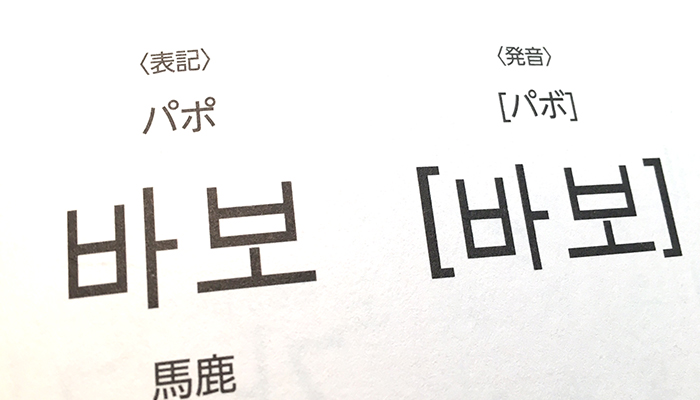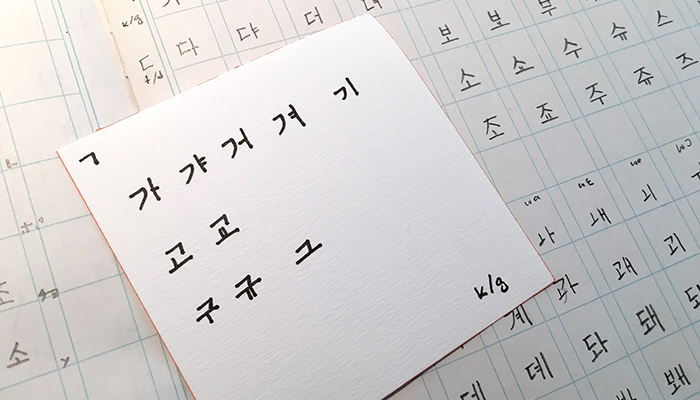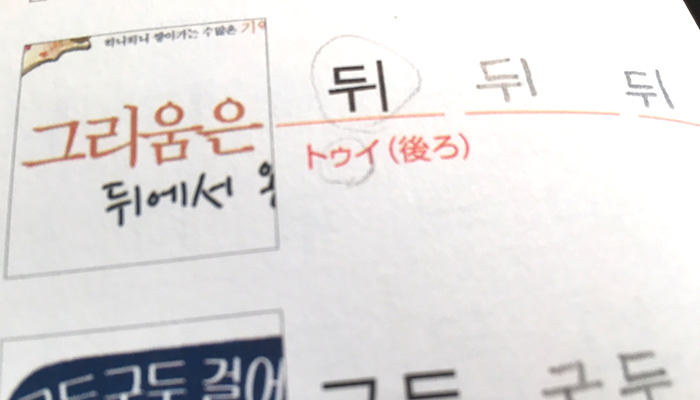#1. 5th day: A Challenge is a Chance – writing Hangul
The writing exercise.
Doing the exercise today, a question came up again: “can I learn a writing system without learning the language?” This question already accompanied me during the one year of MATD at Reading, as classmates worked on the type design of scripts that were unfamiliar to them. I do not have an answer to this, but it became a topic again as my sister asked me why I am not connecting the writing exercises with learning the language.
And of course, the common approach of learning to write is to support the action of learning a new language and being able to use both of them. And I feel it can be related to the discussion about logocentrism. Another big door that I do not want to open yet.
However, there is a saying that we start learning a language by learning swear words. And today I got my first Korean one: 바보 (pabo), the Japanese translation says 馬鹿 (baka) meaning idiot.
On the menu of today were the 5 flat consonants: ㄱ ㄷ ㅂ ㅅ ㅈ.
To connect the 5 consonants with each of the 8 main vowels to create a syllabic block and write it at least 10 times, kept me very busy and I exceeded my practice time a lot. More than yesterday I see the importance of actually writing the characters and I think that I can control the shapes better and memorise especially the vowel shapes which I am writing for the fifth day.
I start to make assumptions how shapes of the consonants change to accompany a vowel to form a syllabic character. Some consonants go through minor changes no matter wether they are positioned on the left half, on the top half or in the left top quarter of the em squad. One character was the champion of transformation. The character ㄱ (k) changes the angel of the turn and even the downstroke very clearly and it also shows interesting ways of interacting with vowel elements.
Yesterday I have mentioned the question whether Hangul is an alphabetic or a syllabic writing system. Philine Bracht and Ken Lunde gave me the feedback: alphabetic, while Hrant H Papazian said: both (alphabetic as well as syllabic). Rethinking about my reading of yesterday and the writing exercise of today, I think it is best described as a hybrid, an alphabet-syllabic system. Still I need to find ways of explaining it better.
Listening of today.
Instead of reading a book, I spend time to find a website that provides me with the different pronunciations of vowels. Also I was wondering during the exercise whether the Japanese Katakana transcription may mislead me… There was the character 뒤 coming with the phonetic トウイ. (The ウ was set small). Accordingly I pronounced it “toui”. Checking it online it was “tui”.
What I could not solve by just hearing, are the differences between: ㅐ /ɛ/ and ㅔ /e/, ㅓ /ɔ/ and ㅗ /o/, ㅜ /u/ and ㅡ /ɯ/. (I am quite bad in reading phonetic marks.) The website sononi.com gives useful explanation about how the shape of the mouth changes.
But I am afraid that to understand those differences, there is the necessity to learn the language…
Reference:


